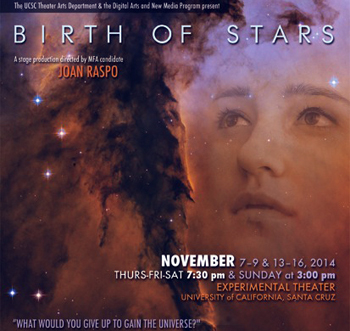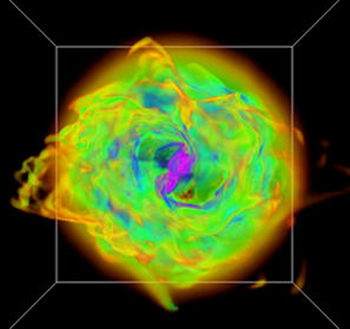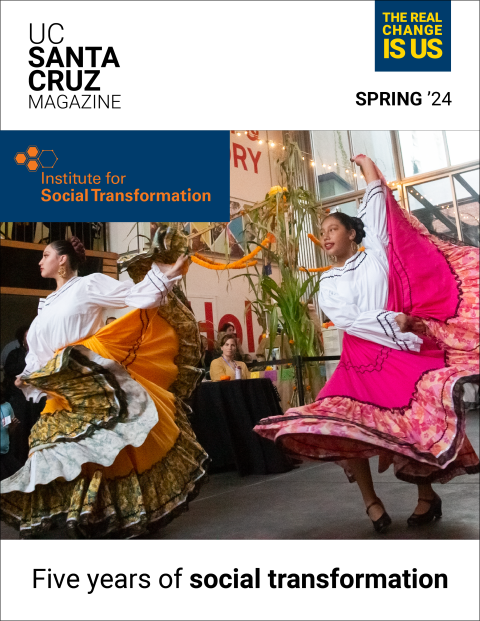What does the birth and death of stars have to do with the lives of real human beings? How do we balance the joy and pain of life in a productive way? Does technology make us less than human…or something more?
These mega questions are themes running through Birth of Stars, an original new play melding scientific data, digital projections, and a human story to explore the parallel between the lives of stars and the people who gaze up at them.
It runs November 7-16 at the Experimental Theater on campus in the Theater Arts Center.
A co-production of the Theater Arts Department and the Digital Arts and New Media Program (DANM) at UC Santa Cruz, the event was created by a research team of scholars, students, and artists--led by Michael Chemers, professor of theater arts and director of DANM, Mark Krumholz, professor of astronomy and astrophysics, and Jim Bierman, professor of theater arts.
Birth of Stars is the story of Sofia, a 14-year-old girl growing up in a rural mountain community in California. Sofia has exceptional gifts-- including an extraordinary facility with science and an obsession with the life cycles of stars. These gifts, however, come at a terrible price.
“Sofia is outcast from her community, cruelly bullied (and cyber-bullied) by her classmates, and misunderstood by her mother, who is very religious,” said Chemers. “The one person who might understand her is a great scientist, but he also wrestles with terrible personal demons. Sofia’s journey through these obstacles is both a compelling and deeply human one, but also, in the end, transcendent and cosmic, in the grandest sense.”
The play combines live action with digital effects, including projections of simulations of stars forming in space. There is also a an interactive online component where the audience can learn about the science behind the play, plus get a rare behind-the-scenes look at the artistic process of creating.
“We were committed to telling a human story that would be strictly true to the science,” noted Chemers. “The digital projections range from visualizations of actual data collected by scientists, to more impressionistic imageries that give the audience insight into the characters’ minds and emotional states. For instance, we get to look into a character’s mind while he suffers a debilitating panic attack.”
“A lot of the play actually takes place online in the world of the play, and so we have various techniques using digital imagery to convey what is happening in cyberspace,” he added. “We’re lucky to have our director, Joan Raspo, a DANM student who has enjoyed a long professional career directing in television.”
Although the interests of students in the cast and crew ranged from theater arts to astrophysics, Chemers noted that the team had no problems interacting and working together.
“Right now there is a real hunger on both sides of the art/science divide, which after all is very artificial to begin with, to venture into one another’s camps,” said Chemers. “I know that the students who did not have a strong background in science (like me) were fascinated by the revelations about the universe that the astrophysicists take for granted. And I think the scientists were really eager to learn new vocabularies for expressing their findings in ways that are not only intellectually, but also emotionally meaningful, for non-scientists.”
“I was really pleased with the patience that both camps showed for one another,” Chemers added. “It was a very collegial and very idea-rich environment. We owe a great deal to my colleagues Mark Krumholz, who is a scientist with an artistic sensibility, and Jim Bierman, who is an artist unafraid of and fascinated by science, for creating this kind of environment.”
Krumholz noted that he especially enjoyed the process of building analogies between natural and human phenomena, and blending them together to make a compelling story true to both.
“Some of the ideas in the play are drawn from contemporary debates in theoretical astrophysics about the origin of stellar masses, including my own work,” said Krumholz. “More subtly, the play draws an analogy between the process by which a star forms and evolves, and the process by which a person, and in particular a scientific prodigy, matures, develops, and eventually ends his or her scientific career.”
“I helped the playwrights understand the science of these processes, and helped them weave those scientific phenomena into a human story,” he added.
______________________________________________________________________________
Birth of Stars will take place Friday, November 7 through Sunday, November 16 at the Experimental Theater, located in the Theater Arts Center on the UC Santa Cruz campus. Tickets are available at santacruztickets.com. This event is made possible by the support of the Arts Dean’s Fund for Excellence, the Porter College Mini-Grant Program, the UCSC Institute of the Arts and Sciences, Mr. Ren Klyce, and MAXON4D. For more information, call (831) 459-4731.





